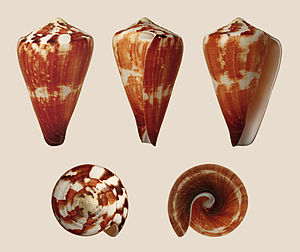Flag cone
| Flag cone | ||||||||||||
|---|---|---|---|---|---|---|---|---|---|---|---|---|

Housing of the Conus vexillum |
||||||||||||
| Systematics | ||||||||||||
|
||||||||||||
| Scientific name | ||||||||||||
| Conus vexillum | ||||||||||||
| Gmelin , 1791 |
The flag cone or flag cone ( Conus vexillum ) is a snail from the cone snail family (genus Conus ), which is widespread in the Indo-Pacific . It feeds on many bristles , especially Eunicidae .
features
Conus vexillum has a medium-sized, firm to heavy snail shell , which in adult snails reaches 6.5 to 18 cm in length. The circumference of the body is conical or bulbous, conical to broad or broadly conical, the outline at the apex is convex and otherwise almost straight. The shoulder is angled or rounded. The thread is low to moderately high, its outline straight to slightly convex. The protoconch consists of three and a half to five and a half whorls and has a maximum diameter of 0.8 to 0.9 mm. The first quarter to two and a half whorls of the teleoconch are covered with tubercles. The seam ramps of the Teleoconch are flat with 2 to 3 to 10 increasing, often dotted spiral grooves. The circumference of the body has weak spiral ribs at the base.
The basic color of the housing is white. In the subspecies vexillum , the body is brown with the exception of a white, alternately wide, spiral band in the middle and another on the shoulder, which is often interrupted and sometimes missing. Dark brown, wavy stripes and tightly packed, coarse to fine lines run above it from the base to the shoulder. The base is dark brown, the edges of the Protoconch yellow. The early seam ramps of the Teleoconch are yellow or olive-colored, the later ones with grayish to blackish-brown radial spots on a white background, the case mouth is white. In the subspecies sumatrensis , the body is covered with blackish-brown axial stripes and flames and with fine, less dense axial lines, which often consist of dense tiny dots and can also be reduced.
The thin to thick, translucent to opaque, smooth or rough periostracum is yellowish olive to dark brown and is covered with spiral rows of fine tufts on the body including the shoulder sometimes at larger intervals.
In the subspecies vexillum , the foot is yellow-green to greenish-black and can turn black on the sides. The top of the foot can have a dotted black line in front of the edge that merges with a black spot under the operculum , and a black transverse band at the front end. The middle section is either uniformly patterned with radial rows of dark brown dots or goes from brown to a blackish-green front blotch. The sole of the foot has reticulated black lines. Young animals in Hawaii have yellow feet. The rostrum is almost black, the antennae gray to black, the sipho dark green or dark gray to black, sometimes with yellowish-green edges. In the subspecies sumatrensis the foot is brown with black markings, the sipho yellow, distally with black spots.
The radula teeth, which are connected to a poison gland , are slender and elongated with a small barb at the tip, which is opposite a blade. They are sawn down the shaft over two thirds of the length, ending in a point.
distribution and habitat
Conus vexillum occurs in the entire Indo-Pacific from KwaZulu-Natal to Hawaii and French Polynesia , Japan and Australia . The subspecies sumatrensis is restricted to the Indian Ocean .
Conus vexillum lives in the intertidal zone and at depths of around 70 m on sand, scree or rocks, often on the upper edges of coral reefs.
Development cycle
Like all cone snails, Conus vexillum is sexually separated, and the male mates with the female with his penis . The female lays her egg capsules under coral rocks in irregular clusters and attaches them to the rock with basal plates on which about 35 capsules sit. One capsule contains around 34,500 to 53,500 eggs with a diameter of 130 to 143 µm, from which it is concluded that the Veliger larvae swim freely for at least 28 days before they sink down and metamorphose into crawling snails .
food
The prey of Conus vexillum consists of polychaeta (polychaeta), in particular from the Eunicidae family , which it pricks with its radula teeth and immobilizes with the help of its venom from the poison gland .
literature
- George Washington Tryon: Manual of Conchology, structural and systematic, with illustrations of the species , vol. VI; Academy of Natural Sciences, Philadelphia 1884. C [onus] vexillum Gmelin., P. 39.
- Walter O. Cernohorsky: Tropical Pacific marine shells. Pacific Publications, Sydney / New York 1978. p. 126.
- Dieter Röckel, Werner Korn, Alan J. Kohn: Manual of the Living Conidae Vol. 1: Indo-Pacific Region . Verlag Christa Hemmen, Wiesbaden 1995. The texts on the individual cone snail species of the Indo-Pacific are published on The Conus Biodiversity website with the permission of the authors (see web links).